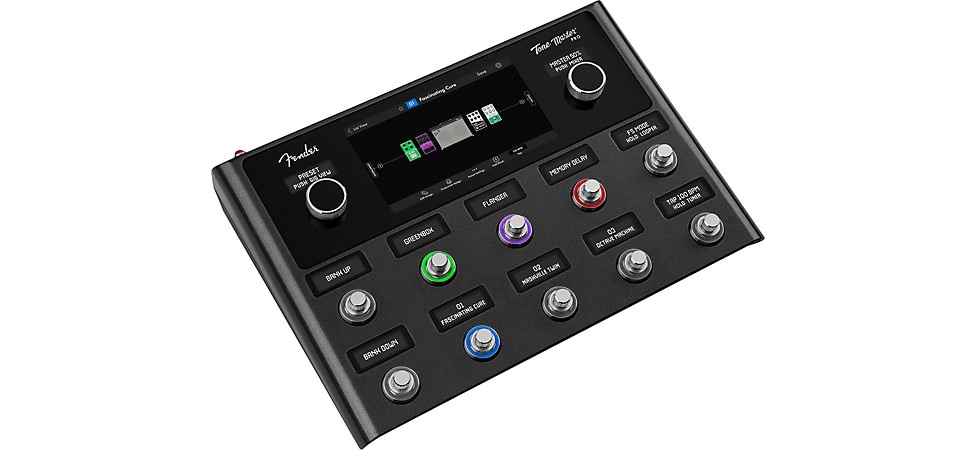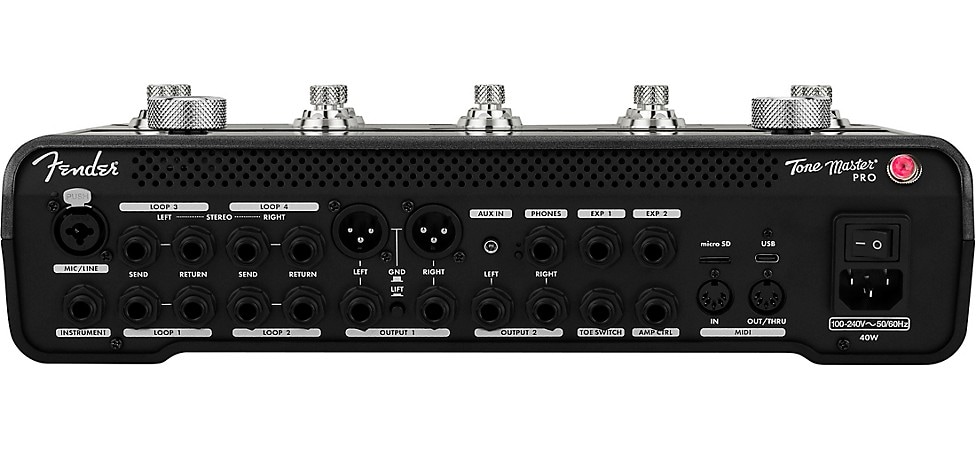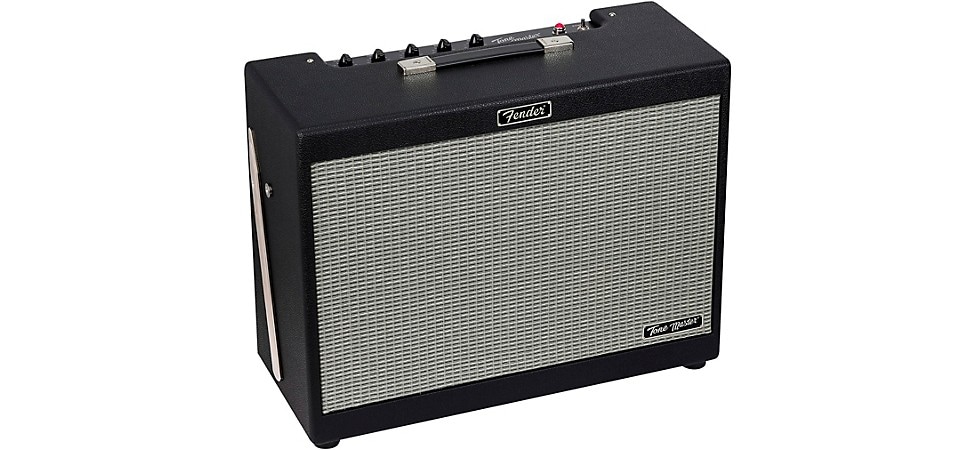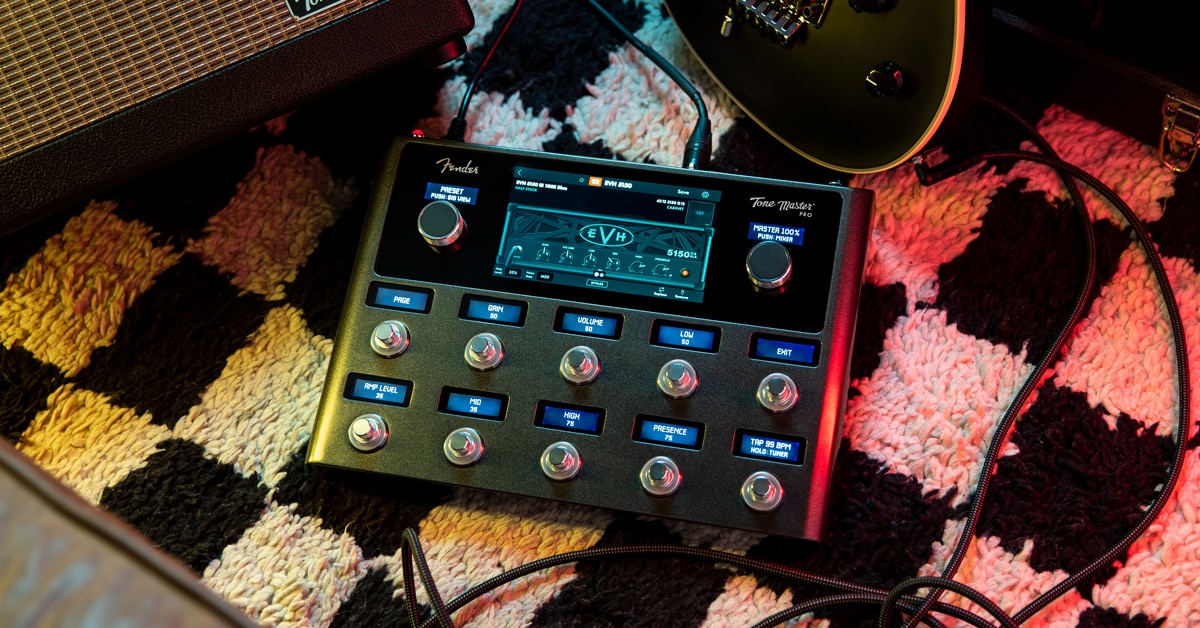The Fender Tone Master series of digital modeling amplifiers scrupulously replicated the sounds of vintage Deluxe®, Princeton®, Super and Twin Reverb® amps for everyday players. It was a tonal epiphany for guitarists who may have never played the original amps, but nonetheless realized they drove many of their favorite songs and wanted to explore those classic sounds themselves.
So, what could Fender do for an encore?
How about encapsulate decades of amp history, a multitude of the coolest speaker cabinets, entire eras of stompbox effects, reverbs from surfy drips to shoegaze-approved galaxies of ambience and a collection of classic studio microphones in a professional, yet incredibly easy-to-use pedalboard and recording interface combo?
The Fender Tone Master Pro provides all of that tone-crafting power and more. Featuring an intuitive touchscreen interface, more than 100 amp and effects models, 1,000 cabinet IRs, pedalboard-style scribble LCDs, rotary encoder footswitches and even a desktop app, the Tone Master Pro appears poised to, as reviewed by Guitar World magazine, become “the modeler that finally converts a wave of digital holdouts to the tech.”
In this interview, Fender Senior Vice President of Products Max Gutnik reveals how the company’s digital engineers celebrate its past, evolve tone construction for today’s players and preserve the authentic Fender sound for future generations of musicians.
As an amp and guitar company that goes all the way back to the mid 1940s, what was the impetus for designing the Tone Master Pro as a pedalboard?
Max Gutnik: The world is changing, and digital is becoming the choice of professionals and the like for amplification and tone. You have acts touring who can't afford the cartage costs of massive amps. You have silent stages everywhere, because many clubs and venues are dual-purpose performance spaces and residences, so shows can’t be super loud. The economics of the music business in general are evolving with the emergence of digital, which is helping to change the landscape in favor of musicians. For our part, Fender has been doing digital modeling for a long time—all the way back to the Cyber-Twin® in 2001. So, this is not new to us, but as more and more musicians turn to digital to create their sound, we wanted to make sure that we at Fender were the absolute authority on what a Fender was supposed to sound and play like in the digital domain.
When we started the Tone Master amp series a little more than four years ago, it was with the express goal of perfectly replicating the tone and feel of our most revered tube amps without compromise. Achieving this goal required us to spend years inventing a completely new hardware architecture and modeling process. The result has been overwhelmingly successful, as Tone Master amps are widely regarded for their authenticity in capturing the sound and feel of our most beloved tube amps, with the reliability and convenience of a modern digital amplifier.
We knew when we started Tone Master amps, that the culmination of the series would be the Tone Master Pro. We imagined all the world’s most iconic amps and effects from the past 70 years—perfectly replicated using the Tone Master modeling process and hardware architecture—all in one place. Then, we imagined the ability to mix and match all those amazing tones and effects in a super powerful and intuitive product that’s as easy to use as a traditional amp and pedalboard, and all housed in a beautiful and robust form factor with enough I/O and capability to be the heart and soul of your guitar tone for the next decade.
I was shocked when I first turned on the Tone Master Pro, because in literally three minutes, I had 98 percent of the functionality down. The interface is that fast and intuitive, and the skeuomorphic design actually triggers emotions because it looks good, and it looks real.
Making it easy for customers to get great tone is just as important as the foundation of what a great tone is. That was a huge impetus of the interface design. We want to celebrate the romance of the amps and effects, and give players a sense of what it's like to own these products as much as we can in the digital domain. That's a big part of the experience.
Our platform strategy across the entire digital portfolio is to make things easy and fun, so users are inspired to dig in and create great tones. We wanted a platform where someone who is familiar with dialing in sounds on a Fender Mustang® LT or GTX modeling amp will already know the basics when graduating to Tone Master Pro.
We definitely felt there should be a lot of familiarity in the customer trajectory—especially as the interface is designed to logically step you through what you’d do in the real world. Perhaps you’re using an EVH amp in the Tone Master Pro, and you see a tube model on stage or at a store. It’s like, “Wow—that’s the amp I’ve been playing in the Tone Master Pro.” The touchscreen and graphics of the Tone Master Pro interface makes it easy to understand, just like the real amp, so you feel a connection to it. And, as Fender makes so many of the amps in the Tone Master Pro, we want that connection to thrive forever.
For instance, using the Tone Master Pro may motivate some people to get the original tube counterpart and have both. Maybe they’ll use the Tone Master Pro for recording, touring and gigging, but when they’re home looking for inspiration, they plug into the analog amp. Or, they can use the Tone Master Pro without the IRs and plug into the front end of a tube amp to get the best of both tonal worlds, as well as all the effects. It's not just one way or another with Tone Master Pro. It's everything all at once.
Did you have explicit user personas in mind when you finalized the Tone Master Pro. Is it more for recording musicians, gigging players, professionals, or enthusiasts and hobbyists?
First and foremost, we wanted to make sure we were making something a professional musician could use on stage and in the studio, and feel they were getting everything they needed. And it’s not just about the models, it’s also about the hardware. To do great digital, you have to do amazing analog. We used very high-end converters and an analog section to make sure the hardware had no compromises to the sound quality. On stage, pros need to seamlessly jump from preset to preset and back, so we needed the performance and feel to be instantaneous. Switching presets had to be gapless. Ultimately, what works for professional musicians benefits everybody downstream.
But while it was designed to serve professional needs, the benefit for everyone is that it's so easy to use. We’ve heard both pros and hobbyists say that Tone Master Pro is the first modeler where they’re not intimidated by how complicated it is. That means we did it right—it's accessible for everybody.

Can you touch on the modeling process for the amplifiers in the Tone Master Pro?
Typically, modeling a single-channel amp takes us about three months. We go from the preamp all the way through to the power amp, modeling every component and series of components, replicating exactly how they perform and interact with each other. One of the benefits of really great modeling is you're reproducing not only the sound of the amp, but the way the amp feels and how it functions at certain settings. For example, we discovered that when the blue channel of an EVH amp is set a certain way, and the red channel is a certain way, there's a level of crosstalk that affects both channels. We had to do the complex math to get the EVH to respond like it does in the real world under all those circumstances. Even though the customer may not understand that’s what’s happening, we need to do that kind of stuff, because when you do it right, it's the most rewarding experience in terms of the depth and breadth of what the amp is really bringing.
The clean sounds are typically the hardest to model. You can still get all sorts of cool nuances in a saturated signal, but when dealing with a clean tone, there’s more complexity going on because of how the guitar interacts with it. There’s so much to account for to ensure a clean Fender Deluxe or Twin sound has all of the authentic character and reacts the way you expect when you percussively hit a string harder or softer.
The Tone Master Pro’s sound-shaping power is obviously very desirable for a recording session or live performance, but it can also serve as an amazing educational tool. Users will not only learn about the legacy of guitar tone, but they’ll also acquire knowledge about studio production and miking—such as what does a Shure SM57 sound like on a particular amp or speaker cabinet versus an Electro-Voice RE20.
It's huge for that, because very rarely will players have access to all of this hardware in the real world. Even if you walk into a music store, they don't have it all—certainly not some of the vintage stuff. And while Tone Master Pro has 6000 impulse responses of various speaker cabinets, we’ve tried to make it really simple to understand how to mic them in the context of the interface. We have this amazingly easy way to use different mic placements on the virtual cabinets. You change mics, change cabinets and change mic placements, and can instantly hear what it’s doing to the sound. If you want a brighter sound, you move the virtual mic to the right. If I want a darker sound, you position closer to the edge of the speaker. All of this is really intuitive and easy to hear, and suddenly this mystery of amp miking and placement becomes something anybody can understand and do.
Could someone deploy the Tone Master Pro to craft a so-called “Frankenstein” amp that doesn’t exist in the real world—such as the preamp from a Fender Princeton going into the power section of a Marshall JTM45?
Creating Frankenstein amps is a cool concept, and you never know where that will go. But if you took, say, a Fender preamp and a Marshall power amp section, and tried to marry them in the digital domain without first creating them in the analog domain, you’re just making up something in the digital world. Because if it hadn't existed in the real world, you can't know what the analog occurrence would have been, and you're not modeling what actually happened. The technology is there to be able to do that, of course, but I think you have to decide how you're serving the main mission of the customer—which is to give them great tone. For us, it's to create a memorialized sonic imprint in the digital domain that says, “This is what a Fender sounds like.” Tone Master is about the replication of what exists.
That being said, we did create head versions of all the amps so you can marry them to speaker cabinets that you may not be able to do with a traditional combo amp. Using a Fender Princeton with a 4x12 cabinet, for example. You can also separate out the reverbs and tremolo effects from the amps, so many amps that did not feature these effects can now have them. Finally, you can set up your signal chain where some effects are pre and post amp, as if they had an effects loop in the real world—even when they don’t.

Perceptions tend to evolve rapidly these days. Do you envision a time when players may be less concerned with replicating classic amp and guitar tones?
What we may see in the future is that someone’s phone becomes their first guitar amp. It’s interesting, because even players who know about the sounds of classic amps have probably experienced them via a modeler, rather than out in the real world. It’s also possible that miking a speaker cabinet on- or off-axis is something they’ve never done outside of a modeling processor. This is a totally different learning path than what you would have gone through a few decades ago. So, you start thinking, “What does a Fender Twin mean to somebody who has never heard anything but a virtual Twin or a virtual Deluxe?” That's why it's so important we get these digital sounds right. Because when they're using a Tone Master Pro to play Beatles or Led Zeppelin covers in their first band, we want to make sure they can authentically capture the inspiring tones that made all of us want to pick up the guitar and buy amps.
Having said that, customers are giving us more permission to be experimental, because maybe they're not coming from such a traditional place. There was a time when if it happened before Woodstock, it didn't matter. You know what I mean? But now, what is the perspective of a customer who has never even heard a real tube amp versus something else they got a great sound out of? What are loopers and sound generators and AI going to bring to the table? All of that stuff is going to impact how permissive the customer is going to be for different and alternative ways to get sounds. We have to be ready for that.
There are a lot of effects and pedal models in the Tone Master Pro, but how does it work with, let’s say, a non-negotiable vintage stompbox that a player absolutely must use?
If someone falls in love with a pedal, it doesn’t matter if we modeled it or not. They want to use the actual pedal that’s part of their sound. As a professional unit, we want Tone Master Pro to be an extension of what you do. So, whether you use that pedal in front of a real amp, or with Tone Master Pro, we don’t want you to compromise.
Now, the only way you can do that with effects loops is to make sure they work. We needed analog relay-based effects loops for vintage pedals and some of the crazy stuff. We also wanted to have the ability to use digital effects loops where you can put pedals anywhere in the chain, because that's so useful and powerful. That's why we have both options. This is a perfect example of serving the pro and the enthusiast. We have to celebrate all of the tone-generating capabilities a guitar player or musician is going to use—not just what's in Tone Master Pro, because we could never put it all in there.
We haven't talked about the FR-10 and FR-12 powered, full-range, flat-response speakers. Where do they fit into the development and practical use of the Tone Master Pro?
When you're making a modeler like Tone Master Pro, you must have a reference source that can replicate what it is as accurately as possible. The problem with many people who use modelers or digital products is they will plug them into normal amps, and that means they'll incur a signal loss. They'll be like, “Why doesn't this sound good?” So, we wanted to make sure we had a playback solution that was a great compliment to Tone Master Pro, and, frankly, all other modelers, as well. Fender has been making amps for decades, and we feel like we can do this really well—whether it's a powered full-range, flat-response speaker, or the tone stack in an amp. So, we approached the FR-10 and FR-12 speakers our own way.
First, we wanted to give them a classic look. If someone is going to put an FR in their backline, we wanted it to have that Fender design that appeals to players. Then, we wanted it to sound uncompromising when you plug in. Some hardware companies choose to compromise on the headphone outputs and conversion quality, because it's expensive, and maybe not as important as the main outputs. We didn't want to do that. Whether you program Tone Master Pro using headphones, and play it through a PA system or FR, we want the sound to be consistent in all places. So, the FR-10 and FR-12 had to be uncolored sonically, but also not lose any musicality in the process—especially as the Tone Master Pro has Bluetooth, and you can stream audio through it and play songs while you’re rehearsing, practicing or jamming. The FRs sound amazing as playback monitors for those situations. I’ve actually played movies through an FR. It's a great audio source.
We thought about how people use real amps on stage, as well. The tilt-back legs on the FRs are important for aiming the sound projection where you can comfortably hear what’s going on, without having to keep turning up the volume. Of course, things usually get loud during a live performance, and your perception of certain frequencies can be impacted by the volume—it’s the Fletcher Munson Curve in action. But we don’t want you to have to change the preset tone in the Tone Master Pro, or even bend down and adjust the global EQ. We wanted you to make quick tone modifications the same way you would on a traditional amplifier—by grabbing a treble, bass, midrange or volume knob. That is why putting those controls on the top panel of the FR-10 and FR-12 was really important.

What about your own use of the Tone Master Pro? Did you experience any presets that ultimately became your favorites?
I have two personal favorites—the Maximus Twin and the Twin Fried EVH. I use Maximus Twin in my bands when I play live. It’s a Twin with some effects and a boost function, and what’s really cool about both of these presets is that you can turn specific effects on and off, and back on again, using footswitch mode. The Twin Fried EVH is a great demonstration of DSP processing power because there's an EVH in there, an FBE-100 and a Twin head—all going into a couple of 4x12 IR cabinets with different microphones and mic positions available. In footswitch mode, I can do things such as turn off the FBE-100, turn on the EVH and control a bunch of effects. You're getting all of this tonal control in a single preset that you can use to do an entire show.
There’s so much that the Tone Master Pro offers, and we’ve covered a lot. Are there any elements you’d like to spotlight, or that we may have missed or glossed over?
Like I said earlier, the ease of use and accessibility of the sounds are the big things. Another thing is the ability to edit the unit by using the footswitch encoders—which makes it feel like you’re in front of an amp or using a pedalboard. Quickly getting to the outcome you want is the magic sauce. Because no matter how good the models are, if you struggle to get the tone you're looking for, it doesn't matter.
On that subject, a guitar player's determination of what tone sounds good is usually dependent on how it feels, so they have confidence when playing. If you're fighting that tone, then you don't feel like you're playing your best. So, we wanted to make sure the unit had that instant feel—no latency—and it felt like you were really on the amp itself.
I should also mention that it’s a great, four-channel recording interface. You can directly record all of the processing in it, use it for reamping—all kinds of stuff. It’s super versatile in the studio. And, hey, it’s sexy too—just a beautiful piece of kit. Those are the things I think people are going to love about the Tone Master Pro. Whether it's used in the studio or on stage, Tone Master Pro can be the centerpiece of your universe.
.jpeg)







